Traditional Mongolian food is influenced by nomadic lifestyles, animal husbandry, altitude, and weather conditions. Seasonal variations also affect the available meals. Summer and autumn are the seasons when dairy products are most commonly consumed. Mongolians prepare meat dishes mostly once a day in summer and autumn. However, we use more meat in winter and spring to consume the calories and protein required during the harsher seasons.
Mongolian Meals and Recipe
Huushuur - Meat filled, deep fried pancake
One of the most popular and widely eaten dishes in Mongolia, you can find Huushuur wherever you go. Huushuur is a meat-filled deep-fried pancake. Mongolian Huushuur is meaty and flavored with salt and onion. The taste varies depending on the ingredients. Huushuur is the main dish of the Mongolian national holiday Naadam Festival.
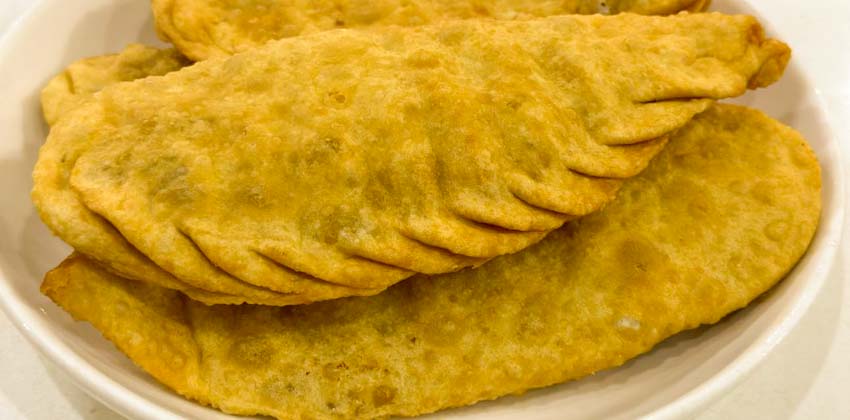
Tsuivan- fried noodles
You may ask a Mongolian man about his favorite meal. The reply could be Tsuivan. Tsuivan is rich and fatty and served in large portions. The recipe is simple with meat, onion, hand-prepared noodles, and some vegetables, and appreciated if it has sheep tail fat. There is a joke that Tsuivan is the third topic among Mongolian men after cars and women.
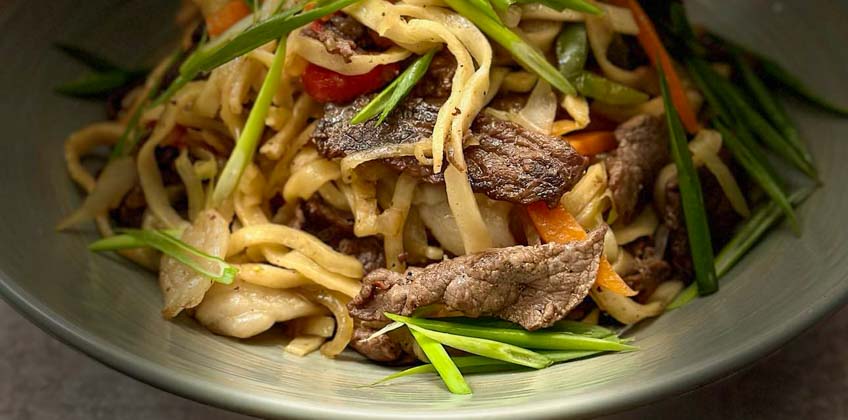
Mongolian Barbecue Horhog – Mongolian popular traditional food
Mongolian barbecue Horhog is the most popular food in Mongolia. When traveling to the countryside, Mongolians want Horhog. Mongolians prepare Horhog in a container with hot stones, meat, and veggies. It should be cooked over an open fire while the hot stones inside the container cook the mutton. It is a dish you should taste when visiting Mongolia.
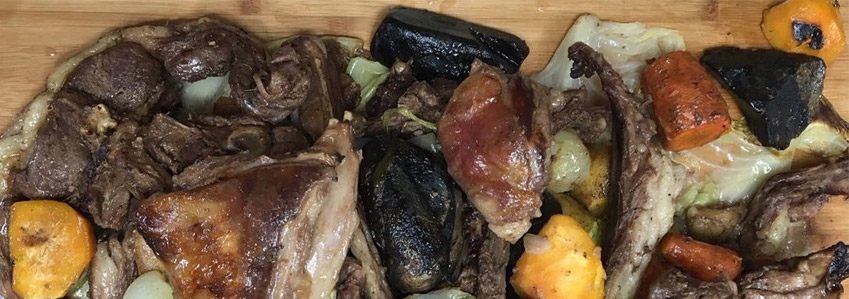
Buuz - meat filled dumplings
Buuz is a popular Mongolian customary dish today. However, because the Buuz was introduced to Mongolia from China, the Mongolian Buuz varies from other countries' Buuzs in its recipe. Buuz can be made from any type of meat combined with fat, ideally, sheep tail fat flavored with salt, onion, and occasionally cumin. Buuz has equine meat as well. Buuz is the primary dish of the Mongolian Lunar New Year and is frequently served during holidays and daily in Mongolia. Also, not harmful to your stomach while traveling as it is cooked on steam.
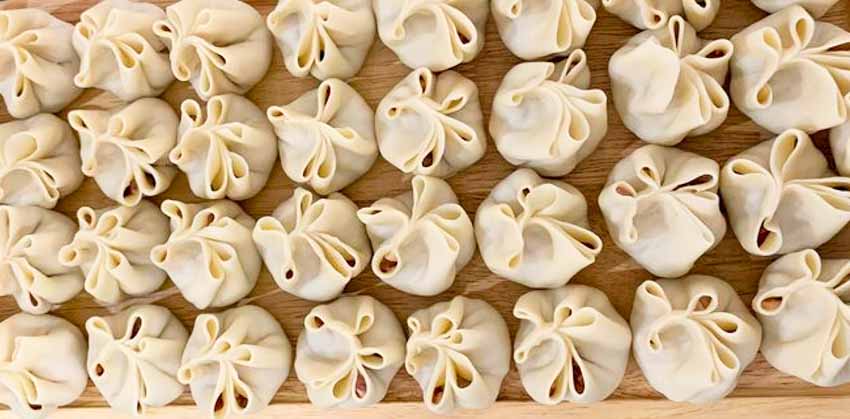
Gobi Bird/Tsagaan Shuvuu
You may think that the little bird in the Gobi Desert is roasted when seeing the picture. This meal's name comes from its shape. To cook the Gobi bird, you should fill a singed sheep tail with minced mutton flavored with salt and onion. Close the open part with a cooking thread and boil in the appropriate amount of water till the tail fat starts to render. This meal is served in the Gobi Desert nomads’ homes.
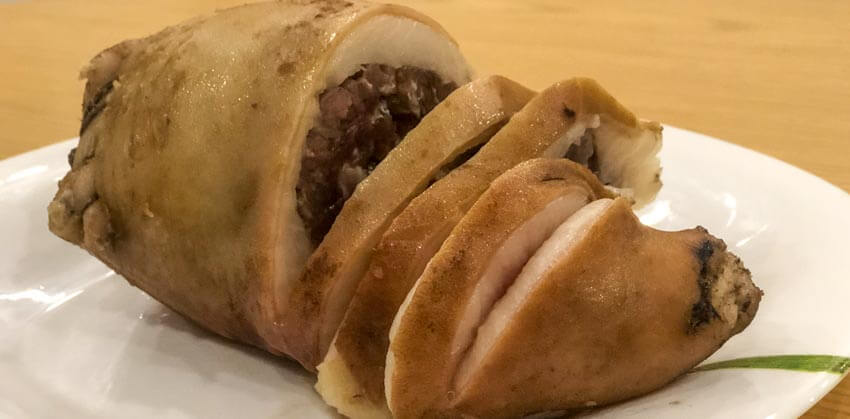
Buhel Mahan Zoog
The Mongolian dish Buhel Mahan Zoog/Boiled meat is a typical meat dish. This basic meal can be composed of one of all types of red meat, cut into chunks along with the bones. The pieces are simmered in salted boiling water until the flesh is tender. You can cook the flour, whole potatoes, onions, and cabbage leaves together. Use the same recipe when cooking Mongolian beef.
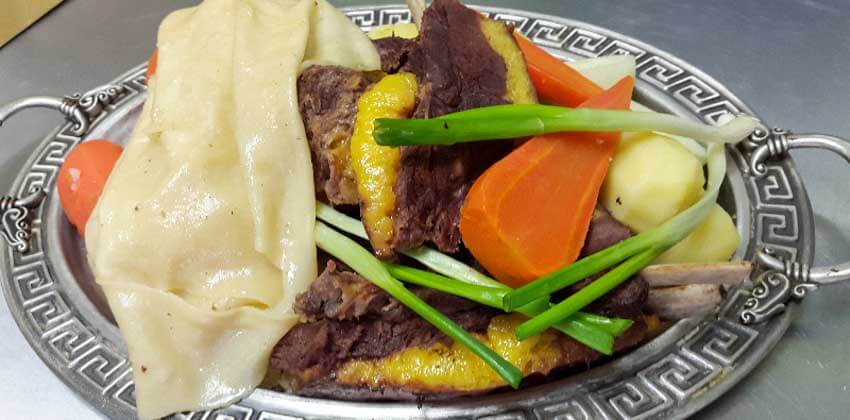
Uuts- Mongolian National Dish
The entire rump of a sheep is boiled/steamed in a large pot with the other sections, sometimes including the head and legs. During the traditional holiday Lunar New Year, traditional parties, and festivals, Uuts is the most renowned dish.
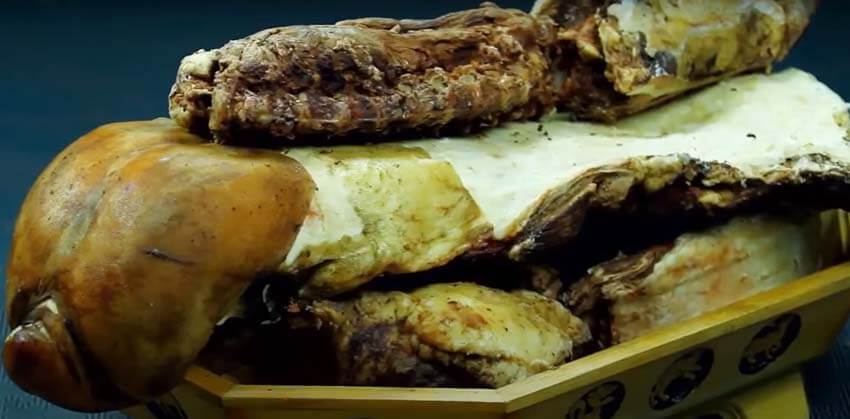
Shorlog
Ancient warriors are said to have hunted animals and roasted meat on their armor while traveling great distances to combat countries. Swords and arrows were used to turn the meat to cook evenly. Barbecue cookery has evolved since then.
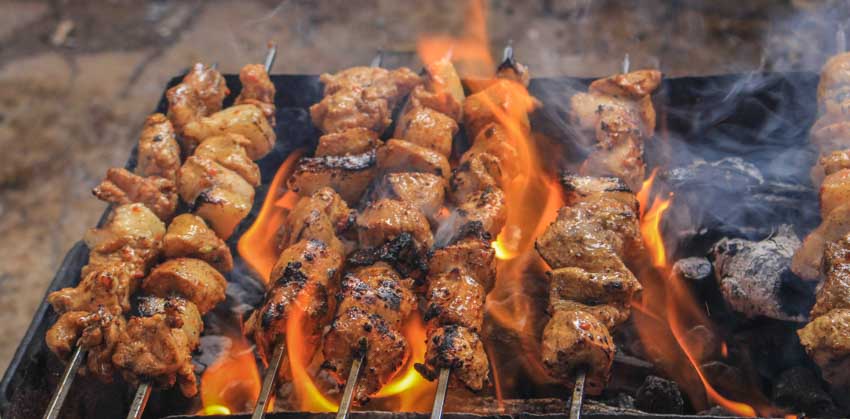
Kaz – horse rib sausage
Kaz is salted and smoked horse meat sausage. To prepare, first, hang meaty horse ribs till thoroughly drained of blood. Then, season it with garlic, pepper, and salt before being stuffed into cleaned horse intestines. The sausages are then either smoked for several hours or dried for several days in an area open to wind and direct sunlight. You can eat the Kaz after boiling well in water. No need to add salt as the rib sausage is already too salty.
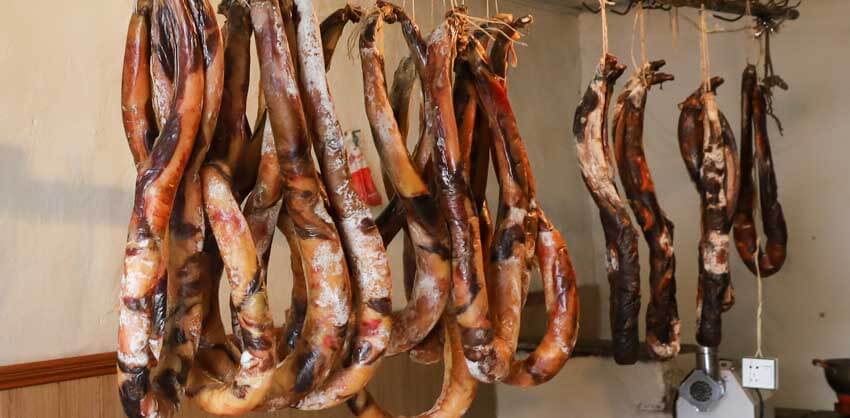
Rib dishes
Mongolians add ribs to several dishes even though the dishes are cooked with plain meat. Ribs enhance the flavor of soups and main dishes alike. To name a few, Noodle Soup with Ribs, Black Soup with Ribs, Ribs and Dumplings Soup, Vegetable Soup with Ribs, Fried ribs, etc.
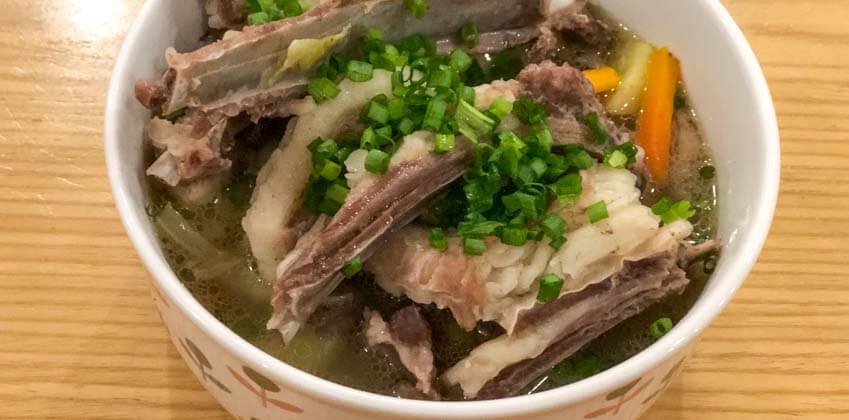
Tail fat fried liver
Easy to prepare and the cooking process takes a short amount of time. The tail fat fried liver is rich in the nutrition and calories needed for nomadic Mongolians living in harsh climatic conditions. You can easily find this dish in Mongolian traditional dish restaurants in Ulaanbaatar or in the homes of your nomad hosts. To cook the liver with tail fat, the tail is heated on a low fire to render the fat oil slightly. This is to equally cook both the liver and fat because fat tend to be cooked slower than the liver. Then add the onion, liver, and salt and fry.
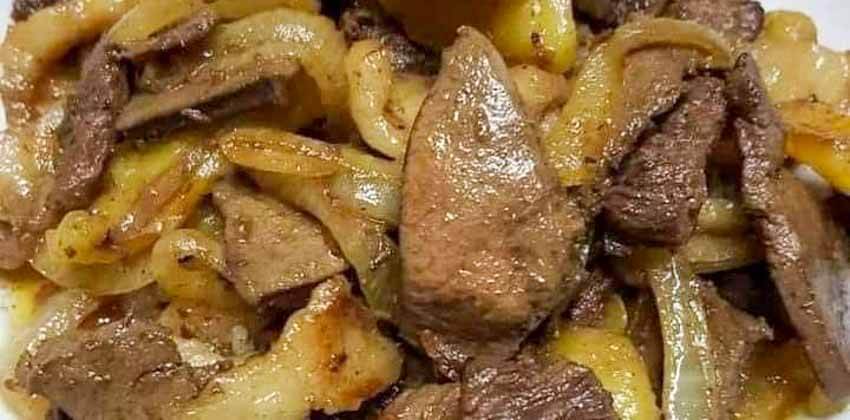
Nettle Dishes
Stinging nettle is a nutritious plant used for both medicinal and culinary reasons. This edible plant grows in spring before the vegetable season. To improve meals' nutrient content, Mongolians add stinging nettle to the ingredients. Common nettle recipes include Nettle Soup and Nettle Pancakes.
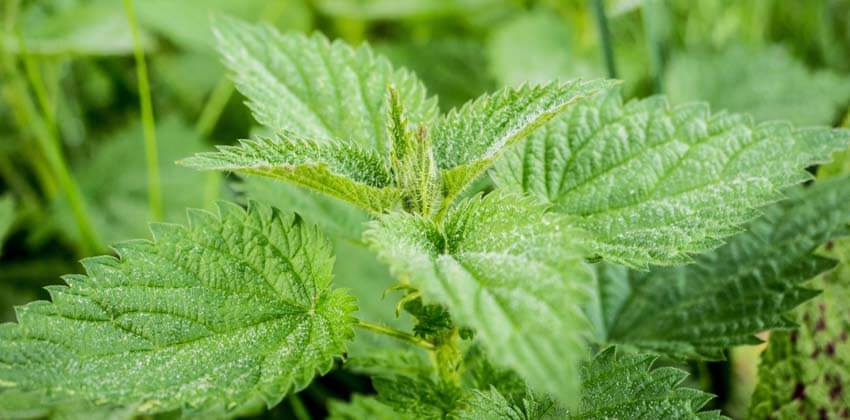
Intestine dishes
When vegetables were not available on the nomadic Mongolian steppes, the herders' economical attitude after wasting an animal's life caused high consumption of animal intestines. Many meals are prepared with intestines, such as Intestine fried noodles, Intestine noodle soup, Intestine fried rice, Intestine Buuz, Intestine Khuushuur, etc.
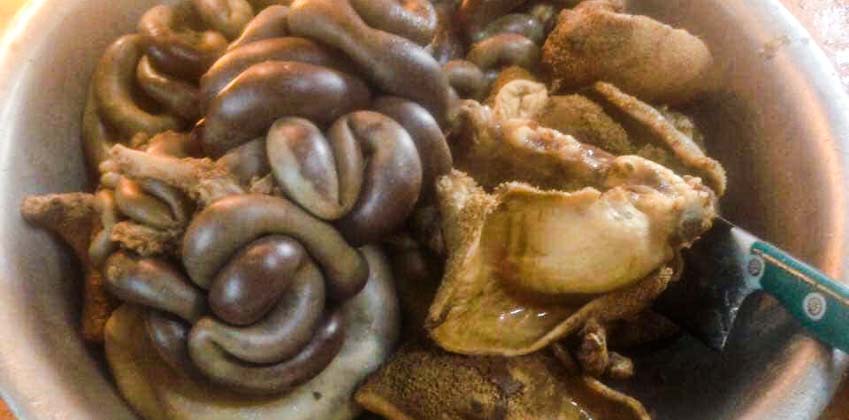
Dried Meat Dishes
When the winter begins, Mongolians dry meat in minus temperatures in their barns and storage gers without losing nutrients and extracts. Goat meat, camel meat, and beef are suitable for drying. It gets tastier as time passes on. Mongolians can keep well-made Borts for 1-3 years without a fridge, while most Borts/dried meat is used and kept until next autumn. It is practically and economically useful for Mongolian nomads as it is lightweight when carrying and has some benefits for livestock growth as the nomads don't need to slaughter skinny animals until the next autumn. Almost all Mongolian dishes can be cooked with dried meat and are found in restaurants year around and at nomad’s gers, especially in spring and summer.
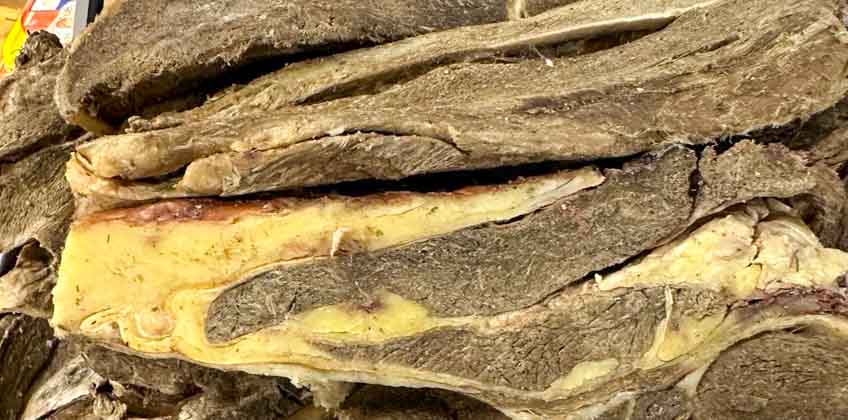
Horse Meat Dishes
Horse meat, also known as the cold weather dish, is most commonly eaten in the winter because it is high in protein and twice as rich in iron and vitamins as other meat. Unsaturated fats are beneficial to one's well-being. The most basic horse meat dish is Aduunii Chaasan Mah/horse meat simmered in salt water. It is preferable to serve the boiled meat cold. When making buuz, Khuushuur, Tsuivan, and Mongolian pilau rice, we also use horse flesh.
Mongolian Soups
Small Dumpling Soup
One of the most popular meals for Mongolians is Banshtai shul, a small dumpling soup. This meal’s main ingredient is meat-filled small dumplings. Other ingredients vary widely. When it comes in just meat soup, it is called Black Soup with Dumplings/Banshtai Khar Shul. If you cook dumplings in vegetable soup, it is called Vegetable Soup with Dumplings, and when cooking dumpling soup with ribs, it is Dumpling Soup with Ribs.
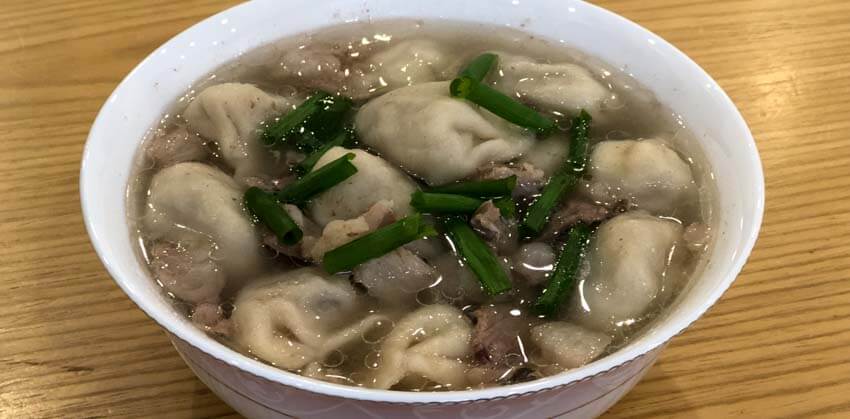
Noodle Soup
Mongolians' primary dish is homemade noodle soup. Because of its common recipe and ease of preparation, nomads consume noodle soup on a daily basis. Boil the homemade noodles in beef, mutton, goat, or camel meat broth. Flavor with salt and onion.
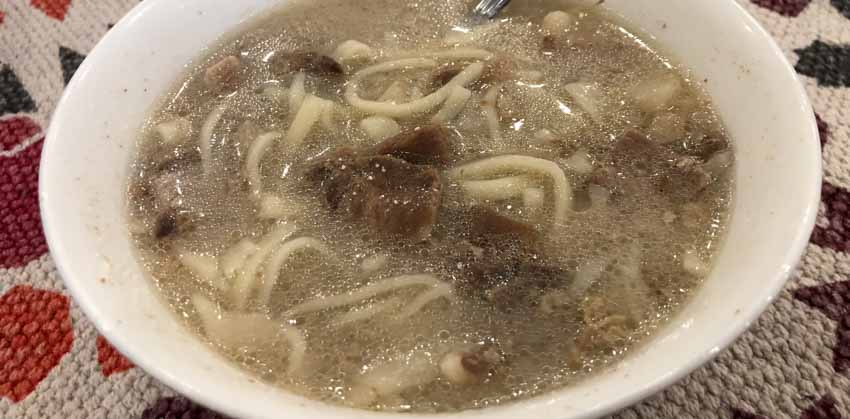
Curd Soup
For curd soup, there is no specific formula. To enhance the nutritional value of regular Mongolian noodle soup, acid curd is frequently added, especially in the winter.
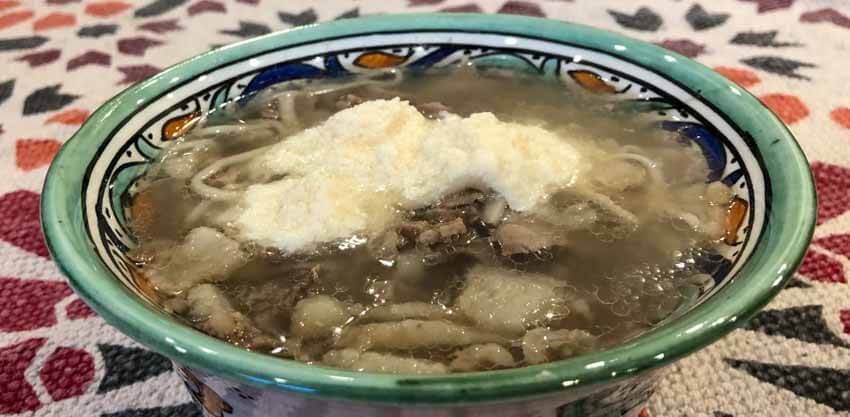
Bituu Shul
The Bituu Shul is traditionally cooked by placing the broth components in an animal gut and boiling it in water. Nowadays, cook the contents on a steamer in a bowl, sealed with flattened dough. We believe Bituu Shul helps us acquire strength and heal fatigue because all nutrients can remain in the bowl while cooking.
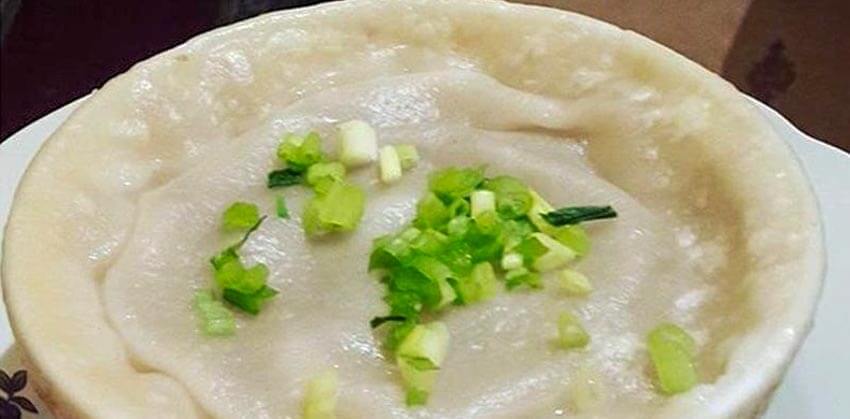
Black Soup With Pancake
Black soup is indeed meat soup flavored with just salt and onion. It is best when served with deep-fried pancakes.
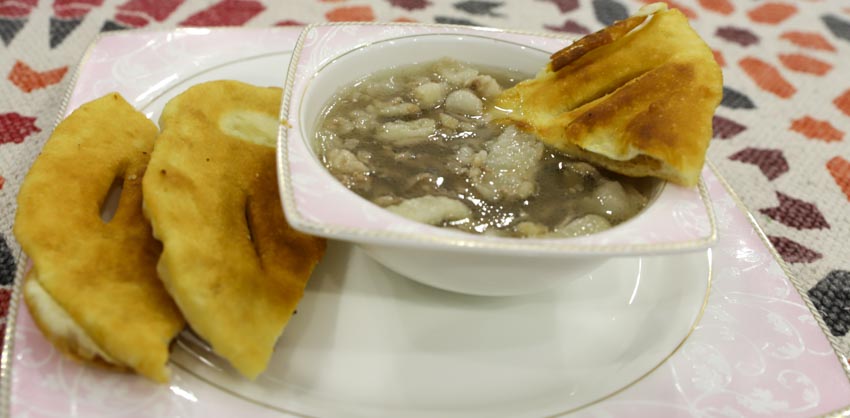
Dried Meat Noodle Soup – Bortstoi Shul
Borts is air-dried goat, camel, and cow flesh that can be stored without a refrigerator all year. Mongolians use Borth in almost all dishes. Dried Beef Noodle Soup/Borthtoi Guriltai Shul is the most popular. In the spring, Mongolian herders prepare Dried Meat Noodle Soup almost every day.
Horse Meat Soup
It is uncommon to prepare soup with horse meat, and you will most likely find it at the gers of your Mongolian host. Horse meat soup has health advantages such as cough relief, fatigue relief, and increased endurance.
Hyaramtsag soup - frozen tripe and blood sausage soup
Hyaramtsag is a frozen mixture of animal blood and intestines in a tripe. Twice as rich in protein, vitamins, and minerals compared to lean meat. Mongolians eat Hyaramtsag soup in spring when other foods lose nutrients after being stored throughout winter.
Mongolian White Food
Milk and Butter Rice - Urumtei Budaa
Originally used for nomads' breakfast, it is now less popular due to the abundance of culinary options. Mongolians cook rice in milk over a low flame while creating clotted cream.
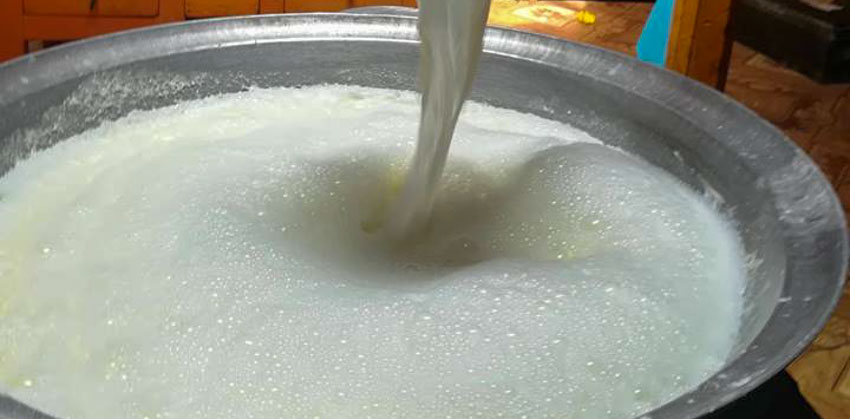
Steamed Rice/Berees
Steamed rice was brought to Mongolia by Buddhists from Tibet and China. It is the most commonly consumed dish in Buddhist monasteries and during funeral ceremonies as this dish does not include animal live-wasting ingredients. Everyone cooks steamed rice at home if they wish. Sugar, butter, and raisin make the steamed rice flavorful.
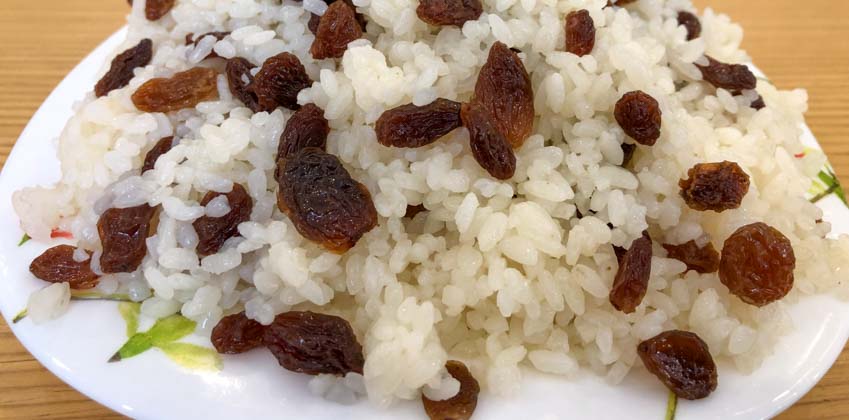
Milk Noodle
Mongolians consume this light meal when they don't want to eat much meat. Boil the milk and water before adding hand-made noodles. Add an appropriate amount of ghee and salt. Cook for 2-3 minutes, and the Suutei Guril/ Milk Noodle is ready.
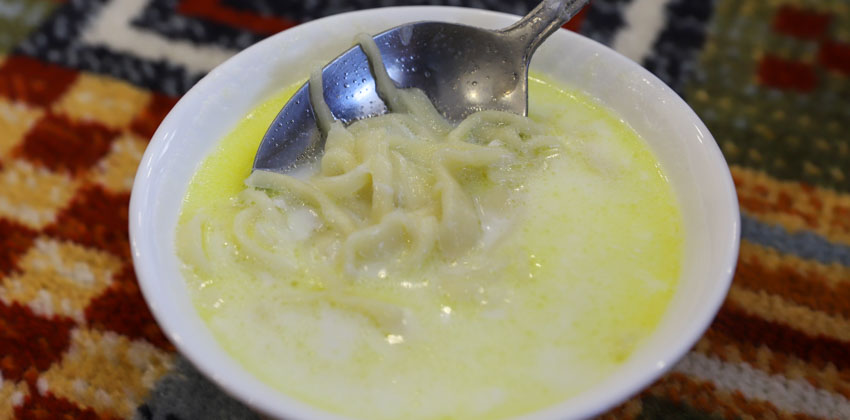
Curd Rice Broth
To gain needed vitamin C and support the digestive system after meaty meals, Mongolians use dairy products and digestible meals in warm weather months. Curd and rice are cooked in broth with yellow butter and presented with or without sugar.
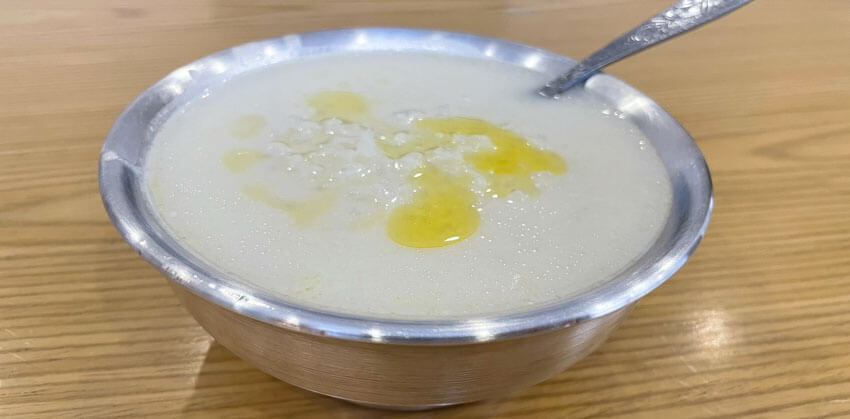
Dairy Products
During summer and autumn, Mongolians consume more dairy products than meaty meals. During the warm season, families cook meals once a day and consume more dairy products. There are 130 types of dairy products. The most commonly used products are Aaruul - dried curd, cheese, yogurt, fermented mare's milk or Airag, butter, yellow butter, and yogurt vodka. Dairy foods are healthy and nutrient-rich because they are rich sources of calcium, vitamin D, protein and other essential nutrients.
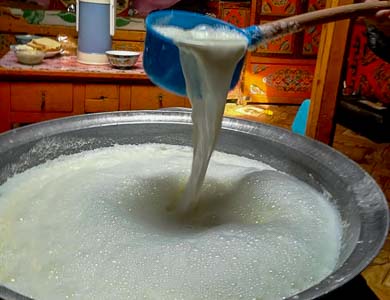
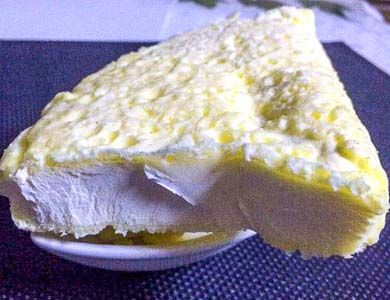
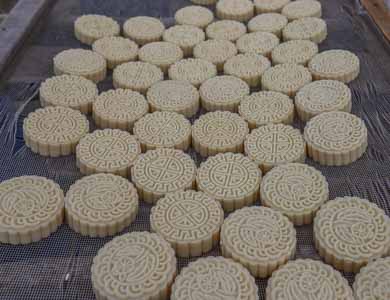
Mongolian Snacks and Desserts
Brawn
Made of sheep and cow legs, brawn was one of the holiday dishes Mongolians spread on the table. The brawn is found in all supermarkets and eaten whenever someone wants.
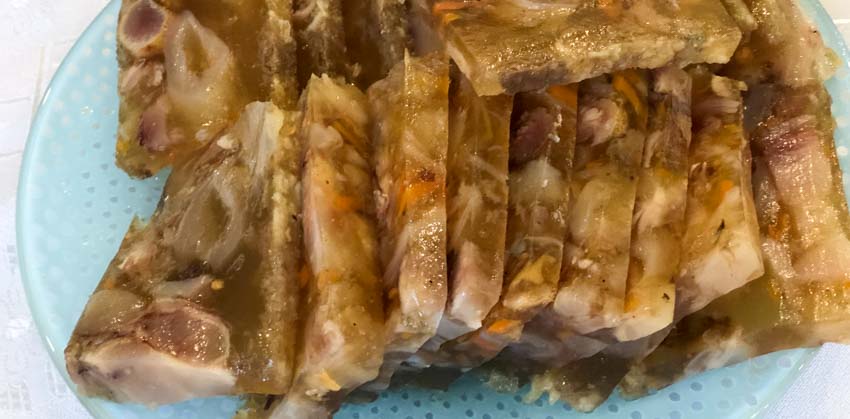
Tongue Salad
Salt water-boiled beef tongue slices are found at most restaurants and family tables during holiday celebrations.
Boortsog
Deep fried dough cookies are comparable to bread as it is served for breakfast, eaten the entire day, travel snack, and offered to visitors at nomads’ homes. Boortsog varieties include salted, sweet, donut-like, and buttery cookies.
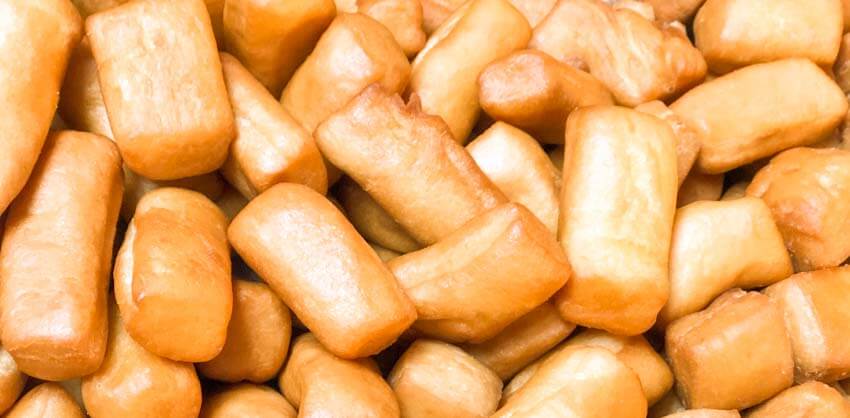
Deep Fried Pancake – Gambir
Deep fried dough cookies are comparable to bread as it is served for breakfast, eaten the entire day, travel snack, and offered to visitors at nomads’ homes. Boortsog varieties include salted, sweet, donut-like, and buttery cookies.
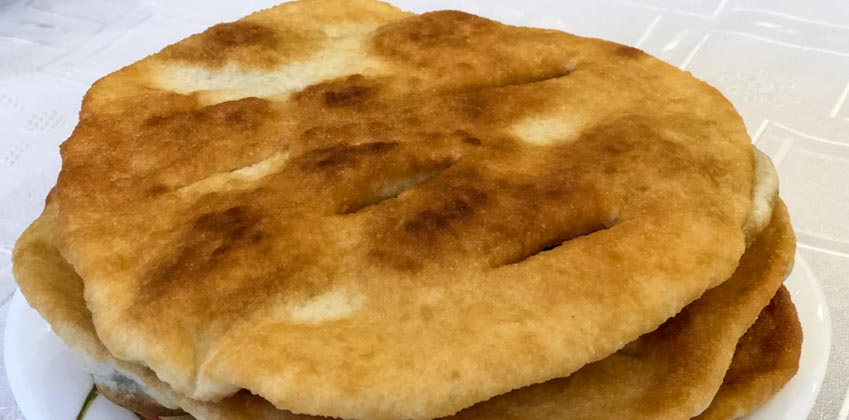
Khailmag-Caramelized Clotted Cream
Khailmag is a Mongolian dessert, as well as a bread spread. To cook Khailmag, you should heat clotted cream in a pot on mild heat, stirring continuously. Keep stirring while adding flour in small amounts till the yellow butter renders. Take the yellow butter and flavor the remaining caramelized cream with sugar and raisin.
Bizarre Foods Mongolia
Some Mongolian meals are considered bizarre. Mongolian homes, local eateries, and traditional restaurants serve some of those meals. But the others have seasons and are hard to sample.
Mongolian drinks and beverages
Among the beverages, Mongolian salty milk tea is the most famous, especially in the countryside. In cities and towns, modern black tea, fruit tea, green tea, and coffee are preferred over milk tea. Mongolians have been using over 100 plants when making tea.
Mongolia Travel Meals - Ger Camp Meals
In Ulaanbaatar, we can choose from the best European and Mongolian restaurants. Ger camps serve European and Mongolian food in the countryside. Meat is the main ingredient for lunch and dinner. Generally, Mongolian cuisine contains more meat. A traditional Mongolian meal can be found in nomads' homes and at local food courts.